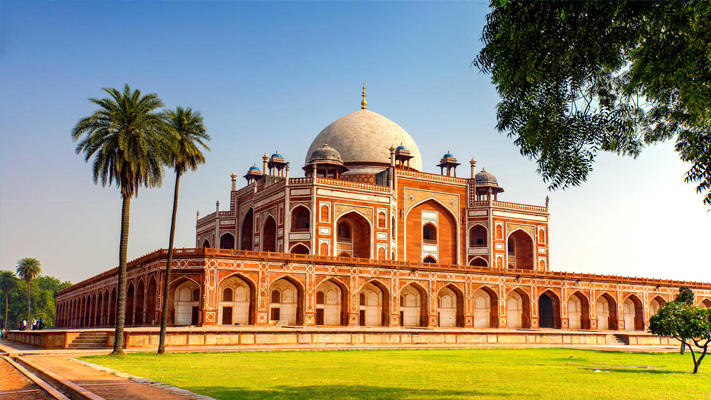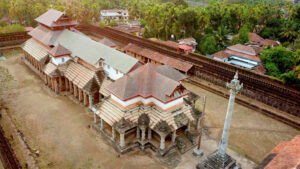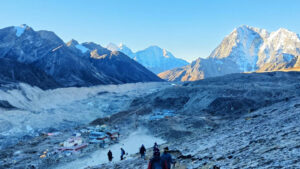HUMAYUN’S TOMB, DELHI – A MARVEL OF MUGHAL HERITAGE

Humayun’s Tomb is a remarkable historical monument located in Delhi, India. This architectural masterpiece was commissioned by Bega Begum, the widow of Mughal Emperor Humayun, in the mid-16th century. It holds great significance as the first garden-tomb in the Indian subcontinent and is renowned for its splendid Mughal architecture. With its red sandstone structure, intricate marble inlays, and a captivating surrounding garden, Humayun’s Tomb stands as a testament to the grandeur and artistic brilliance of the Mughal Empire. This iconic landmark attracts visitors from around the world, offering a glimpse into the rich history and cultural heritage of India.

The tomb serves as the final resting place of Emperor Humayun. Here are some key details:
- Architecture: Humayun’s Tomb is known for its magnificent Mughal architecture, which is a blend of Persian and Indian architectural styles. It is considered a precursor to the grand Taj Mahal. The tomb is built primarily with red sandstone, complemented by white marble inlays and intricate decorative work.
- Design: The tomb stands in the center of a large, geometrically arranged garden called the Char Bagh, which is divided into four quadrants by walkways and water channels. The main structure is a square building with chamfered corners and a double dome. The grand entrance to the tomb complex is through the southern side, marked by a lofty gateway known as the Buland Darwaza.
- Historical Significance: Humayun’s Tomb holds historical significance as the first garden-tomb on the Indian subcontinent. It played a crucial role in influencing the architectural style of subsequent Mughal structures. The tomb complex also houses the graves of several other members of the Mughal dynasty.
- Restoration and Preservation: Over time, Humayun’s Tomb suffered from neglect and deterioration. However, restoration efforts have been undertaken to preserve its architectural splendor. In 1993, it was declared a UNESCO World Heritage Site, and subsequent conservation projects have helped revive the monument to its former glory.
- Tourist Attraction: Humayun’s Tomb is a popular tourist attraction in Delhi, drawing visitors from around the world. Its architectural beauty, serene gardens, and historical significance make it a must-visit destination for history enthusiasts and admirers of Mughal architecture.
What to See
visitors can explore various architectural and historical elements that make it a captivating destination. Here are some notable features within the complex:

- Main Tomb: The main attraction is the grand mausoleum of Emperor Humayun. The tomb is located at the center of the complex and is a double-storeyed structure with intricate detailing. Visitors can enter the tomb and witness the beautiful cenotaph of Humayun.
- Char Bagh Garden: The complex is surrounded by a vast and meticulously designed garden known as Char Bagh, meaning “four gardens.” This Persian-style garden is divided into four quadrants by paved walkways and water channels, symbolizing the concept of paradise in Islamic architecture. The garden is adorned with lush green lawns, flowering plants, and symmetrical arrangements that add to its serene beauty.
- Isa Khan’s Tomb: Located adjacent to Humayun’s Tomb is the tomb of Isa Khan Niyazi, an Afghan noble during the 16th century. It is an excellent example of early Mughal architecture and features intricate details and decorative elements.
- Arab Serai: Towards the southern side of the complex, there is an Arab Serai, which was originally built as a lodging place for Arab travelers. It is a walled enclosure with a gateway and was used to accommodate merchants and visitors from Arab countries during the Mughal era.
- Nila Gumbad: Situated in the western corner of the complex, Nila Gumbad is a blue-tiled structure that stands out among the red sandstone buildings. It is believed to be the tomb of an unknown noble and adds a unique visual element to the overall architecture of the complex.
- Mosque and other structures: There is a mosque within the complex, which is still in use today. Additionally, there are several other smaller structures, pavilions, and tombs scattered throughout the complex, each with its own architectural charm and historical significance.
Visitors can take leisurely strolls through the well-manicured gardens, admire the stunning architectural details, and soak in the peaceful ambiance that prevails within the Humayun’s Tomb complex. It is a fascinating place where history, art, and nature seamlessly blend together.
Visitor Experiences and Activities
Visitors to Humayun’s Tomb and its surrounding area in Delhi can engage in a variety of experiences and activities. Here are some popular options:
- Explore the Tomb Complex: Spend time exploring the intricate architecture and design of Humayun’s Tomb. Admire the craftsmanship of the red sandstone and white marble, observe the ornate carvings and inlays, and appreciate the overall grandeur of the mausoleum and its surrounding structures.
- Stroll through the Char Bagh Garden: Take a leisurely walk through the beautiful Char Bagh Garden surrounding Humayun’s Tomb. Enjoy the well-manicured lawns, symmetrical flower beds, and tranquil water channels. The garden provides a serene and picturesque setting for relaxation and photography.
- Photography Opportunities: Humayun’s Tomb and its surroundings offer fantastic photo opportunities. Capture the stunning architecture, intricate details, and symmetrical gardens. The interplay of light and shadow, especially during sunrise or sunset, can result in breathtaking images.

- Attend Light and Sound Show: Experience the mesmerizing light and sound show held in the evenings at nearby monuments like the Red Fort. These shows narrate the history of Delhi and its notable landmarks, adding a dramatic touch to the cultural and historical significance of the city.
- Visit Nearby Monuments: Explore other historical monuments located in close proximity to Humayun’s Tomb, such as the Qutub Minar, Jama Masjid, or the Red Fort. Immerse yourself in the rich history and architectural marvels of these iconic landmarks.
- Street Food and Shopping in Chandni Chowk: Head to Chandni Chowk, a bustling market located near Humayun’s Tomb, to indulge in Delhi’s vibrant street food scene. Try local delicacies like chaat, kebabs, and parathas. Additionally, explore the narrow lanes for shopping opportunities, including textiles, jewelry, spices, and more.
- Cultural Performances and Events: Keep an eye out for cultural performances, art exhibitions, and events happening in Delhi. The city often hosts music concerts, dance performances, and festivals that showcase the diverse cultural heritage of India.
- Visit Museums and Galleries: Delhi is home to numerous museums and galleries where visitors can delve into art, history, and culture. The National Museum, National Gallery of Modern Art, and Crafts Museum are just a few notable institutions worth exploring.
History
Humayun’s Tomb has a rich history closely tied to the Mughal Empire and the reign of Emperor Humayun. Here is a brief overview of the history of Humayun’s Tomb:
- Architectural Design: The construction of Humayun’s Tomb began in 1565, under the supervision of Persian architect Mirak Mirza Ghiyas. The architectural style was influenced by Persian and Indian traditions, and it served as a precursor to the later Mughal architectural marvels, such as the Taj Mahal.
- Construction Period: The construction of Humayun’s Tomb took around eight years and was completed in 1572. The labor force included skilled craftsmen and artisans from various parts of the Mughal Empire and beyond.
- Historical Significance: Humayun’s Tomb holds historical significance as the first garden-tomb on the Indian subcontinent. It served as a precedent for subsequent Mughal architectural projects, leaving a lasting impact on the architectural landscape of the region.
- Dynastic Tombs: The tomb complex not only houses the grave of Emperor Humayun but also serves as the final resting place for several other members of the Mughal dynasty. These include Bega Begum herself, Emperor Jahangir, Empress Hamida Banu Begum (Akbar’s wife), and various other princes and princesses.
- Neglect and Restoration: Over the centuries, Humayun’s Tomb suffered from neglect and deterioration. It was eventually taken over by different rulers, and the garden fell into disrepair. However, restoration efforts began in the early 20th century, and substantial conservation work has been carried out to restore the monument to its former glory.
- UNESCO World Heritage Site: In 1993, Humayun’s Tomb was recognized as a UNESCO World Heritage Site, acknowledging its cultural and historical significance. This designation has further emphasized the need for its preservation and maintenance.

Best Time to Visit
The best time to visit Humayun’s Tomb in Delhi is during the winter months from November to February. Here’s why:
- Weather: Delhi experiences hot summers and chilly winters. During the winter months, the weather is cool and pleasant, making it comfortable for outdoor activities and sightseeing. The average temperatures range from 9°C (48°F) to 20°C (68°F), providing a pleasant climate for exploring the tomb complex and its surroundings.
- Comfortable Conditions: The winter season offers a respite from the scorching heat of Delhi’s summers and the high humidity of the monsoon season. You can enjoy exploring the tomb complex without the discomfort of extreme temperatures.
Clear Skies: Winter in Delhi brings clear skies and lower levels of air pollution compared to other seasons. This means better visibility and a clearer view of the intricate architecture and details of Humayun’s Tomb.


















































